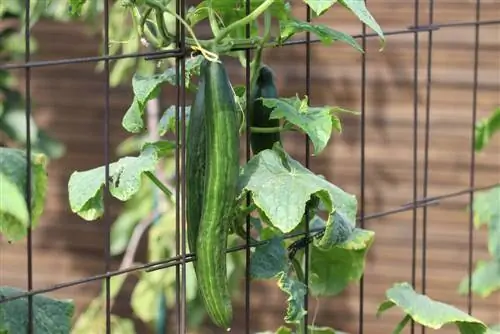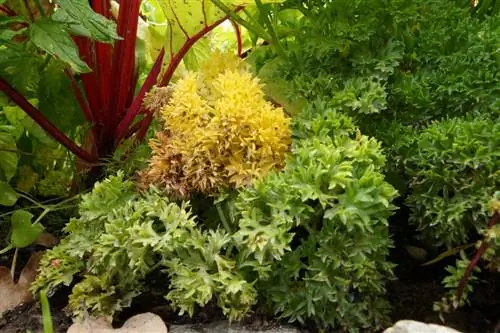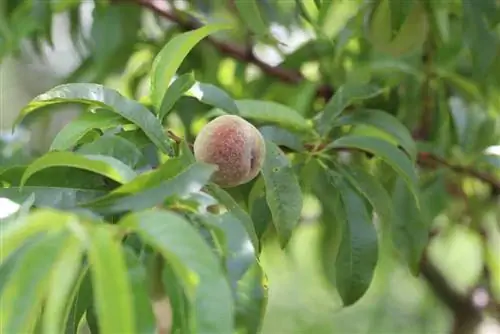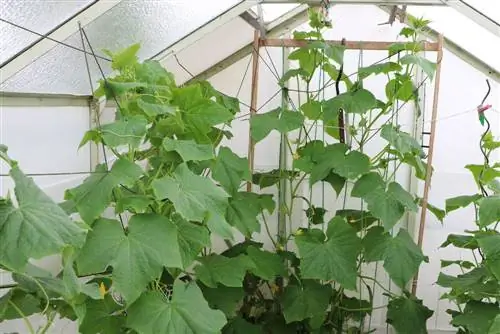- Author admin [email protected].
- Public 2023-12-17 03:39.
- Last modified 2025-01-24 12:45.
When the first yellow leaves appear on your cucumber plants, you should immediately start looking for the cause. This can be harmless but can also be a serious infection or pest infestation. If you react too late, your plant may no longer be able to be saved and the hoped-for and desired harvest will not be achieved.
Do yellow leaves also occur on greenhouse cucumbers?
Your cucumbers can get yellow leaves even in the greenhouse. The causes are similar to those for outdoor cucumbers. However, the room climate or care errors are particularly common reasons. Air that is too dry and/or drafts can easily lead to spider mite infestation. Be sure to ensure sufficiently high humidity and consistent air circulation. When watering, avoid waterlogging and do not plant your cucumbers too close together.
Tip:
Do not plant cucumbers and tomatoes in the same greenhouse. The two plant species prefer opposite climates and cannot thrive together.
What causes yellow leaves?
- Nutrient Deficiency
- drought
- Fungal infections (cucumber wilt, verticillium wilt, powdery mildew and downy mildew)
- Leaf spot disease
- Cucumber mosaic virus
- Aphids
- Spider mites
- Draft
Nutrient Deficiency
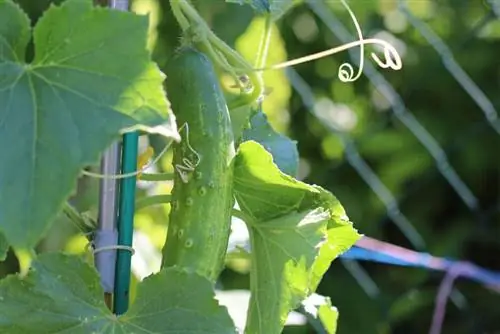
Cucumbers are among the so-called heavy eaters. These are vegetables that have very high nutritional requirements. It's best to add a good portion of mature compost or rotted cow or horse manure to the soil when planting. For a quicker effect, you can mix the compost with horn shavings. Alternatively, use a good organic complete fertilizer or a special cucumber fertilizer according to the manufacturer's instructions. A second fertilization in July is recommended unless you have given long-term fertilizer.
drought
For good growth and juicy fruits, your cucumber plants not only need plenty of nutrients but also a lot of water. If this is missing, the cucumbers become slightly bitter. Water your plants regularly, preferably every morning. Use lukewarm, stale rainwater for this. With a layer of mulch you keep the soil moist and loose, while at the same time the fruits stay clean. Always water the root area and not the leaves.
Fungal infections
Fungal infections tend to occur on cucumbers in the greenhouse. The main ones that should be mentioned here are cucumber wilt, verticillium wilt and powdery mildew and downy mildew. The course of the disease progresses rapidly in the first two infections. Despite a good supply of water and nutrients, the plants are very weak and wilted. When infected with powdery mildew, a whitish coating first appears on the leaves before they turn yellow and fall off.
Can the cucumber plant still be saved?
If it is cucumber wilt or verticullium wilt, then unfortunately you cannot save your cucumber plants. Remove the infected plants immediately and dispose of them in household waste or by burning them, never in the compost. The pathogens can survive there and later spread to other plants. Other infections are definitely treatable if they are detected early. A proven home remedy for fungal infections is skimmed milk. Mix the milk with water in a 1:3 ratio and spray your cucumber plants daily. Prepare the mixture fresh every day. After about a week you should see success and the mushrooms will die. In contrast to the use of chemical agents, cucumbers treated with skimmed milk can be eaten at any time.
Leaf spot disease
Leaf spot disease affects various vegetables and can be transmitted to other plants. In its early stages, this bacterial infection only shows yellowish spots on the upper side of the leaves. Only later do the leaves turn yellow, then brown. By injuring the plant, the bacteria get inside and can also overwinter in the soil. The risk of an infestation is particularly high when the humidity is high.
Cucumber mosaic virus
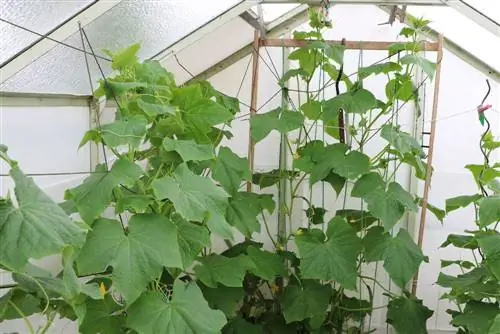
When infested with the cucumber mosaic virus, the older leaves in particular turn yellow, while young leaves tend to get yellow spots. The fruits are also infected, they become deformed and can no longer be sold. However, the virus cannot be transmitted to humans. Dispose of the affected plants and the fruits of neighboring plants. Before you replant the site with cucumbers, you should replace the soil. The infection can also be transmitted with garden tools or through aphids.
Aphids
Aphids are more likely to occur on outdoor cucumbers and only rarely in the greenhouse. When infested, the leaves of your cucumbers become crippled and develop a sticky coating called honeydew. The leaves then turn yellow and fall off. Neem oil, spraying the affected plants with a milk-water mixture (ratio 1:2) or the use of beneficial insects, which you can get from any well-stocked gardening store, are suitable for treatment.
Spider mites
Spider mites prefer to appear in greenhouses. The animals are so small that they can hardly be seen with the naked eye. You can recognize the infestation by the fine webs that are usually found on the leaf axils and edges or by small, light dots on the cucumber leaves. Later, the affected leaves turn brown and turn increasingly yellow. If you don't react quickly enough, your cucumber plant will become bare and die. However, chemical treatment is not necessary. Home remedies such as neem oil, showering with a hard jet of water or wrapping individual plants in plastic film can also help. The use of beneficial insects is also very effective.
Draft
Drafts mainly occur in the greenhouse and cause the leaves of your cucumbers to yellow. Therefore, ensure consistent air circulation without drafts. Close the ventilation (window, door) in the evening and open it in the morning when it is no longer so cold but not too warm either. It is best to plant outdoor cucumbers in a location protected from the wind.
How can I prevent yellow leaves?
The best prevention is choosing the right location for your cucumber plants and providing appropriate care. Cucumbers like it warm, airy and moist. However, you should avoid moisture, drafts or wind. The soil should be permeable, not too heavy and at least 10 °C warm. Water the plants regularly but not too much and fertilize as directed. Too much fertilizer can also harm your cucumber plants.

